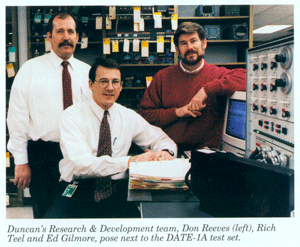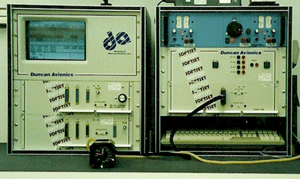With only $30,000 and 90 days, Ed Gilmore, then Duncan Aviation Avionics Bench Tech was challenged to design and develop a working prototype to replace the Collins 980L autopilot test set.
He did it. That was 1981 and only the beginning.
 Original R&D Team circa 1984
Original R&D Team circa 1984 With the help of a local community college instructor and another former Duncan Aviation team member, Ed designed and built the DATE 1 (Duncan Aviation Test Equipment).
It was probably the first-ever computer controlled test set in General Aviation. It used an Apple II-E computer with whopping 64K of memory. It was functional and remained in service for many years.
This test set laid the innovative foundation for what would eventually become Duncan Aviation’s Research and Development (R&D) team. Established in 1984, the R&D department was initially created to support Duncan Aviation’s Avionics Satellite network.
The initial Avionics Satellite shops opened up across the country with the first generation DA test equipment that consisted of large panels taking up a lot of space. In order to grow, the equipment needed to shrink. R&D’s task was to develop test equipment that integrated the current equipment into smaller boxes with increased testing capabilities. But another important requirement was for the equipment to look high-tech and “cool”.

Photo of an original Softset developed by the Duncan Aviation R&D department.
By 1985 the team began the development of equipment that used software rather than hardware called SoftSet. SoftSet was able to test 80 percent of the avionics units that arrived at Duncan Aviation for repair or overhaul.
By 1990 DATE 1 was upgraded to DATE 1A, converted to run on a Macintosh computer and included the addition of Artificial Intelligence (AI). AI assisted in troubleshooting units and offered solutions based on repair history. The equipment got smarter with each test and became more accurate with repair recommendations.
By the mid-90s, both SoftSet and DATE 1 were advanced further with the ability to handle an advanced number of capabilities with a significantly smaller footprint…and they looked “cool”.
DATE 1B became fully automated in 1996 significantly reducing test times. For example the 4.5 hour test of a 562A-5M5 Collins A/P was reduced to 50 minutes and the eigh hour test of the CA-200 Sperry A/P was able to produce results in only three hours. This freed the technicians to do other things and get the units returned to customers quicker.
For the last 30 years, Duncan Aviation’s R&D has provided far more than just support for the Avionics Satellites. The lion share of their projects are smaller dedicated circuits, mockups, test boxes, modules, and mechanical jigs for the rest of the company.
These projects have helped facilitate Duncan Aviation to hold and grow in the avionics repair market, by providing quality test equipment, support documentation and assistance with certification.
Chris Hogg, R&D Tech, says that this innovation is a partnership between R&D and the technician on the floor. “When the technician sees an opportunity to make how they do their job better, faster or more efficient, they get us involved. We work together to provide services that bring the idea to reality, which is very gratifying. We have had more than a thousand such projects, each a story unto itself.
Other R&D Designed Projects
The Falcon Flight Control Force Tool measures the force required by the pilot to move the control wheel and rudder pedals on Falcon 2000, 900 and 50 series aircraft. It has been recently granted ‘tool equivalency’ status by the FAA after an extensive comparison to the original factory tool.
The R&D also crafted Tail Stand Alarms that notify the mechanics prior to the aircraft making contact with the tail stands.
R&D utilizes 3D printing technology to reduce fabrication time and project costs. It has also been used to provide mockups of in-house developed antenna mounts for aircraft.
DATE 1C upgrade is in development and will replace the current Mac computers used in the Duncan Automated autopilot/flight director Test Equipment with PCs.
The development of this software and equipment is one of the many examples demonstrating how Duncan Aviation employees strive to stay at the front of business aviation, providing innovative, responsive and revolutionary customer service.
Innovative technology has a ripple effect that doesn’t end when a project is over. Today’s fresh new ideas become the foundation and infrastructure for tomorrow’s next big thing. This natural evolution allows those who are willing, the ability to think creatively and find the next step.


